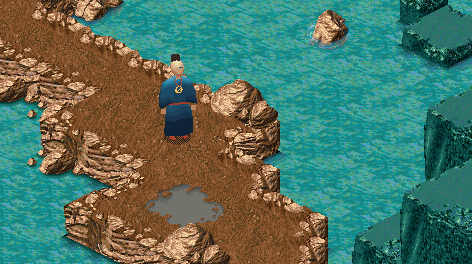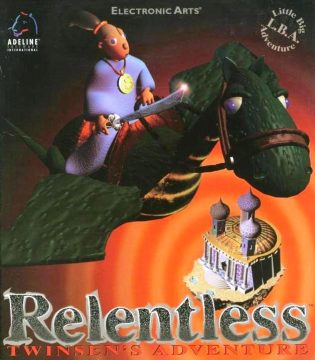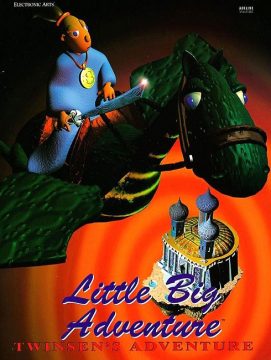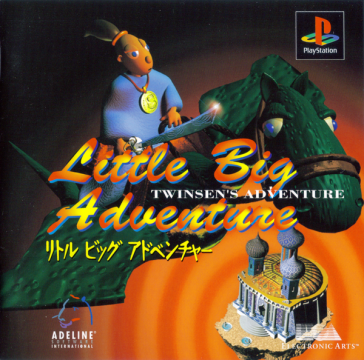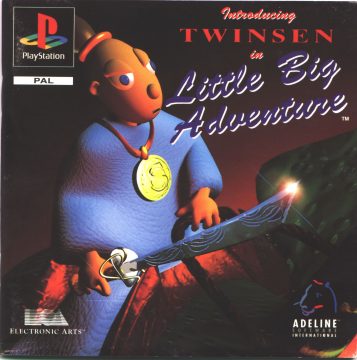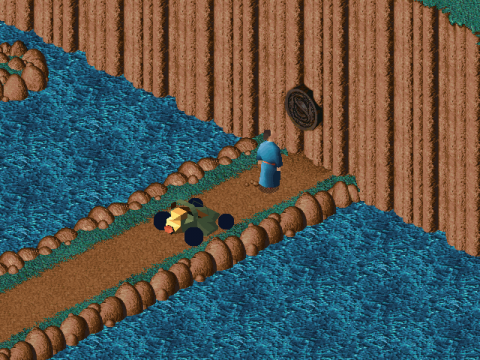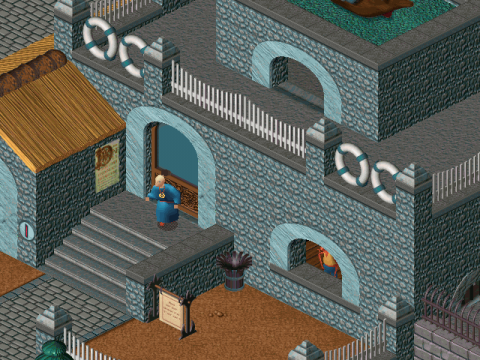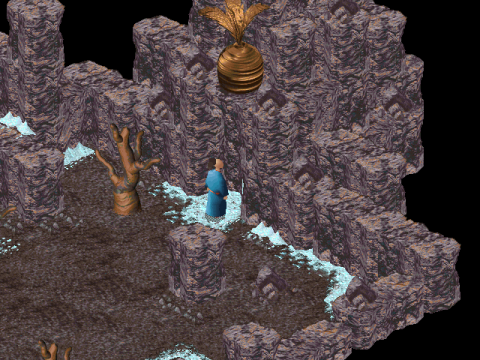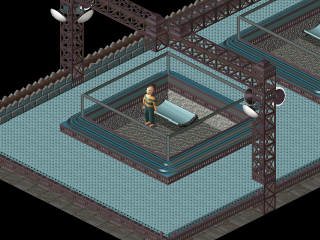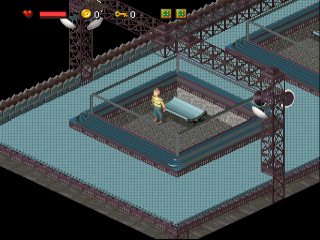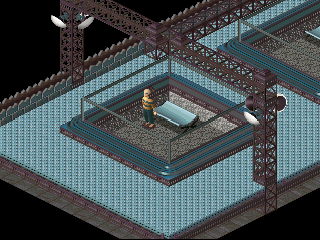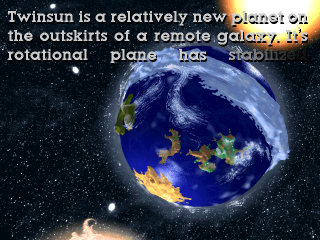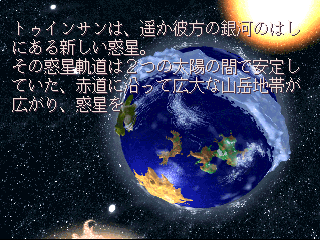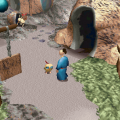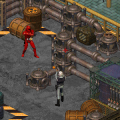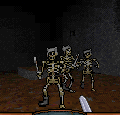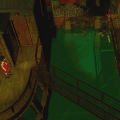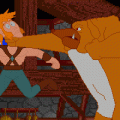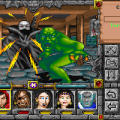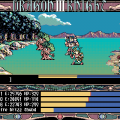- Little Big Adventure
- Twinsen’s Odyssey
CHECK COMPARISON SCREENS
Founded in 1993, Adeline Software was born from the dispute between the development team led by Frederick Raynal and publisher Infogrames over the future of the Alone in the Dark franchise. Based in the city of Lyon, France, the team set out to create a whimsical action adventure using techniques they had learned during the creation of Alone in the Dark. Their first game, Little Big Adventure, made it to European shelves in October 1994. Shortly thereafter it was released in the US under a different name, Relentless: Twinsen’s Adventure. Published by Electronic Arts, the game quickly gained a cult following on the PC as a result of its unique gameplay and captivating world. The French had already gained a reputation for crafting outlandish, creative game worlds in such games as Another World and Flashback, and the Little Big Adventure series would prove to be no exception. Presented using cutting edge 3D technology, the game is one of the first of its type to make the jump into the third dimension. As an aside, Raynal was first inspired to work in 3D while porting the 1990 3D platform game Alpha Waves to MS-DOS. Alpha Waves is widely considered to be the very first example of a platforming game in a 3D space and wound up being quite influential on a number of future Infogrames projects.
Following the release of Little Big Adventure, Adeline would go on to create a sequel, a time travelling brawler, and even begin work on a now cancelled sequel to Flashback. By the late 90s, however, most of the team had left to form another studio, No Cliché, which was responsible for creating games for Sega Dreamcast. Shortly after the demise of the Dreamcast and the cancellation of Raynal’s return to survival horror with Agartha, eight years would pass before a new game, bOxOn for Nintendo DS, would be released. Raynal even had a hand in the presentation of Battle Tag, the real life melding of video games and laser tag which was presented during the 2010 UbiSoft E3 press conference. Today key members of the original team including Raynal are working on a remake of Little Big Adventure for modern platforms including smart phones.
Little Big Adventure, at its core, is an open ended action adventure series in the vein of Falcom’s Ys games or The Legend of Zelda, in which players are tasked with exploring a large world while battling hordes of enemies, speaking with its inhabitants, and solving puzzles along the way.
In Little Big Adventure, progress is controlled by the acquisition of items, such as keys and tickets, and the completion of tasks while the game’s narrative is mostly driven through fully voiced dialogue sequences peppered with the occasional pre-rendered CG video. Along the way you’ll adventure through what could be thought of as “dungeons,” while flipping switches, finding keys, solving puzzles, fighting mobs of enemies, and sneaking past guards. Twinsen’s health gauge is replenished through collecting hearts while a four leaf clover serves as an extra life. Unlike many of its contemporaries, stealth was actually encouraged and rewarded in Little Big Adventure. Some areas even feature alarms which can be triggered by nearby enemies if you happen to be spotted bringing in reinforcements by way of teleporters. Being spotted doesn’t immediately trigger the alarm, however, as the enemy must physically run to and throw the switch leaving you time to dispatch them. The systems aren’t quite as polished or tightly designed as modern stealth titles and the discreet option can feel pretty sluggish, but it adds a nice layer of depth to the mix.
The inclusion of behavior modes stand as one of the more unique features introduced in Little Big Adventure. It works similar to the selectable actions in Alone in the Dark: The player always has access to four behavior modes which alter the way in which you can interact with the world. Simply holding the CTRL key reveals four options: “Normal” which is used for general exploration and engaging in conversation; “Aggressive” engages hand to hand combat; “Athletic” allows you to run and jump; and “Discreet” allows you to quietly sneak past guards. The games sport a single action button which handles a different function for each behavior mode such as jumping while in Athletic mode and attacking while in Aggressive. According to the creators, the idea behind this system was to emulate the change in mood that a person might experience under varying conditions. Character movement is handled using “tank controls” also similar to Alone in the Dark, so pressing left or right rotates Twinsen while the up and down keys move forward or backward.
In addition to the behavior modes, the player very quickly gains access to a magic ball in both games which can be aimed and thrown in order to defeat enemies and interact with puzzles. The magic ball requires quite a bit of finesse in order to aim properly, however, making it difficult to use. Even worse, waiting for a missed shot to return can leave Twinsen wide open to attacks. Often times enemies can attack in waves, causing Twinsen to be knocked backwards with each successive hit. Luring individual enemies away from the pack and disposing of them one on one becomes a necessary tactic if you plan to survive some of the more difficult sections. Between the difficulty of using the magic ball, the limited range of your melee attacks, and the relentless assault from your enemies, it is safe to say that combat is far and away the weakest element of both games.
If you can look past the series shortcomings, however, you’ll find a sprawling set of games with a lot of memorable and interesting content on offer. Both games feel a bit clunky by today’s standards, but they are well worth a look.
The first game takes place entirely on the fictional planet Twinsun, a planet which is orbited by two suns, resulting in frozen tundra encircling its equator. Four different races inhabit this world – Quetches, Rabbibunnies, Grobos, and Spheroids – resembling anything from humanoid rabbits to walking soccer balls. Twinsun has fallen under the rule of Dr. Funfrock who has herded these four races into the Southern hemisphere for their supposed protection. Using portal technology capable of sending its users to any connected points across the planet, Dr. Funfrock employs an army of clones in order to maintain strict control over citizens. Under Funfrock’s control, the islands have fallen under martial law forbidding the discussion of any and all things relating to the Goddess Sendell. So we begin with our plucky hero, Twinsen, who has been experiencing visions of this nature resulting in his incarceration within one of the asylum facilities after he is caught talking about their meaning. The player begins by escaping from prison and returning home to find Twinsen’s girlfriend Zoe in an attempt to explain and understand the situation at hand. Shortly after Twinsen arrives at home, however, Zoe is kidnapped by two Grobo-clones, which then sets in motion the rest of the adventure. What begins as an attempt to rescue his girlfriend becomes something much greater, as Twinsen discovers that he is a descendant of a race which has long since protected the planet. You must help Twinsen discover his true power and overcome the many challenges he may face in order to restore balance to the planet.
The planet Twinsun is dotted by a multitude of islands and land masses across its surface and you’ll travel to each of them over the course of the game. You’re always free to tackle just about every situation as you see fit despite the fact that the quest is ultimately rather linear. It is possible, for instance, to go directly to Dr. Funfrock’s fortress and attempt to take him on very early in the game. Of course, Twinsen is no match for his automated turrets stationed out front but it plants the idea that the player is free to explore the world as they see fit. Twinsen is able to travel to different islands through the use of non-controllable vehicles, such as ferries, along with a flying dinosaur-like creature named DinoFly.
The behavior system works well most of the time, often allowing for different approaches to each scenario, but it is not without fault. For instance, only normal mode can be used to interact with the environment or start a conversation but, limited by slow movement speed in this mode, you’ll wind up using Athletic mode for quicker environment navigation resulting in the need to change behavior frequently. Athletic mode has its own troubles as well, however, with Twinsen taking damage every time you run into a wall. Also, as noted above, combat can become a bit frustrating at times throughout the game. Twinsen eventually gains access to a sword, however, which improves melee range a bit. Even still, the lack of an invincibility window upon taking damage makes for some very frustrating segments. Thankfully, for much of the game, it is possible to avoid encounters entirely using the aforementioned stealth system which helps reduce the frustration.
Despite these issues the world delivers an atmosphere strong enough to overcome the game’s technical and design limitations. The game walks a fine line between the saccharin and the bitter, often juxtaposing flowery fields and cuddly creatures with themes of persecution and war. It’s the kind of place where the doctors and guards you might defeat while escaping from an asylum each disappear with a resounding “BOING,” while leaving hearts and gold coins in their place. It’s an “unhappy-happy” kind of place. There’s a lot to see as well with islands offering up everything from seaside towns to large snowy mountain ranges, all the way to boiling hot deserts. It is through these moments of exploration and discovery that the game is often at its most memorable. Towns are full of individually animated citizens going about their day, while clone guarded checkpoints serve to limit access to certain areas. You’re always free to explore and push the limits of the game world however you see fit, though. Want to gain access to an area you shouldn’t yet visit? No problem, just punch or sneak your way through. Not enough coin for a shop item? Steal it and sneak out.
The world itself is rendered through a combination of gouraud-shaded polygons and pre-rendered isometric backgrounds all displayed at a crisp 640×480 resolution. The engine was capable of displaying half a dozen or more characters on screen at one time without incurring a performance penalty. This allowed the creators to deliver appropriately bustling environments which really helped sell the player on the idea of a densely populated planet. It saw release on the PC first on CD-ROM, with a pared-down floppy disk version appearing at a later date. The floppy version contained the full game but lacked the Redbook audio, voice acting, and pre-rendered CG cutscenes of the CD-ROM version, instead replacing them with static images and an all MIDI soundtrack. The game also saw a much later release on the Sony PlayStation in both Europe and Japan. Early in development a Super Nintendo version had also been planned, but no information or images of this version currently exist. In 1994 the game was quite a sight and, thankfully, still manages to hold up reasonably well today. In those days, most PC games, particularly those with 3D graphics, were rendered at 320×200 or other similarly low resolutions. Little Big Adventure managed to more than double the resolution while keeping a brisk framerate even on a mid-range 486 with just 4mb of memory. Despite its innovative technical feats, the engine is not without flaws. To the annoyance of many gamers, the game screen did not scroll, only changing camera placement when the player reached an invisible barrier; however, game developers did allow players to re-center the camera at any point by tapping the Enter key. Furthermore, the isometric viewpoint naturally obscures certain parts of the map, but again this annoyance was taken into account by making those portions of the map transparent as Twinsen approaches.
The CD-ROM version featured a full suite of voice acting and was available in multiple languages. In addition, the game delivered a wonderful CD audio soundtrack composed by Philippe Vachey, which was crucial in defining the atmosphere. Shortened MIDI versions of the CD tracks were occasionally used when the full song was not appropriate. Unfortunately, the use of redbook audio meant that the CD-ROM would not be accessible for retrieving data while music was being played. As a result, when travelling between major zones in the game, an installation screen will appear which copies all relevant voice data to your hard disk drive temporarily for quick access. It does improve performance while playing, but this lengthy install process can certainly become aggravating as you begin to travel between islands more frequently.
As the game shares quite a bit with what you’d expect from a console game it’s no surprise that it received a port. Technically speaking the game should have been a breeze for the PlayStation hardware as pre-rendered backgrounds coupled with polygon objects would become commonplace throughout the system’s life, but the end results were variable. The PlayStation version was released in both Japan and Europe, but the two releases couldn’t be more different. The Japanese iteration, released in 1996, is a technical mess of a game. With just a single character on screen the game struggles to deliver even 20 fps, while a comparatively busy scene can result in single digit framerates. These technical mishaps wind up rendering this release nearly unplayable.
In March 1997, however, a PAL version of the game was released for European PlayStation owners. Unlike the Japanese release, this version ran beautifully on the PlayStation hardware. Sporting a resolution of 640×256, the image was 25% sharper than the 320×240 Japanese version, but more importantly the framerate was smoothed out to deliver a fairly consistent 50 fps under most conditions. FMV sequences were also displayed at a higher color depth in this version. Considering the advantage the PlayStation commanded over a 486 PC of that era and the quality of the European release, it’s anyone’s guess as to why the Japanese release turned out so poor.
There are mild gameplay changes present between the two as well. The European release features the same character and enemy placement as the PC version while the Japanese release actually lowers the overall number of characters on screen, no doubt to compensate for poor performance. Both versions feature improved audio, however, with the FM synthesis MIDI eliminated in favor of superior tracks. The European version relies entirely on Redbook audio with a great number of additional tracks present on the disc, whereas the Japanese version uses a mix of Redbook and synth like the PC version, but with better results. Control wise, mapping each behavior mode to one of the four shoulder buttons allows for efficient management of your behavioral state. In addition, some of the refinements that would later appear in the sequel made their way into the European version. Running around in athletic mode, for instance, no longer results in Twinsen taking damage every time the player runs into a wall. This version even adds a useful HUD to the mix, which provides information you would otherwise find only in the menus. Unfortunately, as this version is exclusive to PAL regions, there is no easy way to enjoy it on an NTSC display without resorting to emulation and, at that point, the PC version becomes preferable.
Those looking to give this game a shot on modern hardware should take a look at “LBAWIN.” This small program was designed by one of the original coders who worked on the game and allows the game to run smoothly under modern versions of Windows. In addition to the compatibility features, the port also allows a number of tweaks to the original gameplay. You can enable a consistent action button, remove wall hits, enable screen-relative controls, and even install the entirety of the voice data to your hard disk. When combined with a keyboard-to-joystick mapping utility, the game becomes quite playable on a modern PC with a gamepad in hand. It’s the premier way to experience the game at this point.
